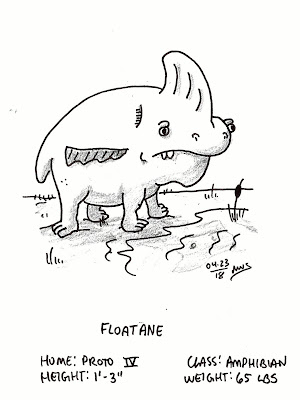Diger
Digers are subterranean wasp like creatures with stingers on their heads. The stingers inject a numbing agent that enables the creature to drag its victim into its burrow. Once there, the digers community encases the victim in webbing, saving for later meals.
Hornam
Hornam are vegetarians through and through. A group of ten can strip an areas fruit trees in less than a day. It's a taxing appetite for us to keep up with here at the zoo. Their horns are hollow, and are actually pressure sensors that help them know when the weather is changing.
Scather
Scather scutter around the dirt plains of Proto. They tend to stay in groups, always on the lookout for danger. The creature almost always have a single fully developed feather on its head, and proto-feathers on its tail. It's a strange development for a single species to have feathers at different stages of development, but it works well for scathers.
Morstiz
Morstiz roam the plains of Senti V, grazing on whatever vegetation they can find. They are mostly solitary creatures, joining in groups only when a threat is detected. Their muscular hind legs can inflict a lot of damage on any attacking predator.
Norbol
Norbol live on the open plains of Lami. Despite their large tusks and clawed face appendage, they are grazing animals. The tusks are for defense, and the claw is used to grab grass and bring it up to the animal's mouth so it doesn't have to bend over. There is a thick hair on the creature's back which reflects the rays of Lami's twin suns, keeping the animal cool.
Slipner
Here we have a slipner from Ronoh. The planet itself is very muddy, and this creature has adapted to it well. It can skim the top of the mud without sinking too far in, which makes it quite a fast mover. It often looks like it is just sliding on the mud. Slipners use their scoop shaped head to clear any exceptionally large clumps of dirt or debris from their path.
Behemacea
Behemacea are the giants of the Florn oceans. They eat by filtering out small lifeforms through a series of perforated skin sheets that cover their mouths. Unlike earth whales, this mammal has developed gills, enabling it to remain under water indefinitely.
Subscribe to:
Posts (Atom)
















